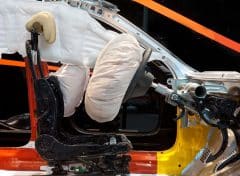By: Maor Hovav
Air bags are one of the most important safety measures in a car, and probably one of the most important inventions in the history of transportation in general. They save thousands of people every year, and are considered one of the main reasons for the constant decrease in the number of road casualties.

Vehicles manufactured today are equipped with a number of safety accessories that are required by law, such as seat belts and warning triangles. Over the years, more advanced protection mechanisms have been added, which contribute significantly to passenger safety, such as airbags and a system to prevent wheel locking. These mechanisms are integrated in most of the vehicles produced today and affect both the safety of driving and the costs of maintaining the vehicle, including mandatory insurance, comprehensive insurance and more - in the automobile industry and the industries surrounding it, including Car insurance, realized that the presence of protection systems in a car reduces its chances of getting into an accident.
איך זה עובד?
An airbag is actually an inflatable bag made of hard nylon, connected to a mechanism that includes a compressed gas tank. During a car accident, the overturning or the impact causes a sudden deceleration of the vehicle and a sensor system detects this and estimates the intensity of the impact. If the impact is severe, the mechanism causes a controlled explosion that fills the pillow with gas in a fraction of a second. In this way, the cushion prevents the driver and passengers from being hit by the steering wheel, windshields and other objects in and outside the vehicle. A few thousandths of a second later the gas cools and the cushion partially contracts, allowing passengers room to move and breathe.
The first trick
The first invention in the field was recorded in 1951 by an American industrial engineer named John Hetrick. The trick developed his invention based on his experience with compressed air systems in torpedoes from his time serving in the US Navy, and he did this in order to provide protection to his family following a car accident in which the family members were involved.

So the first trick was to submit an application for a patent for a "safety cushion in vehicles". A kind of inflatable pillow based on a system of compressed air, which was released by means of a spring that was activated by the driver or following an impact on the bumper. The trick's airbag mechanism consisted of a heavy weight that rested on the spring located inside a cylinder. When the vehicle slowed sharply, the weight would compress the spring, which in turn opened a valve inside a tube and allowed the compressed air to flow through the cylinder and fill the airbag.
The patent was indeed approved in 1953, but unfortunately for the American engineer and his heirs, the first commercial use of the airbag was only recorded nearly 20 years later, when the patent expired.
Two scientific challenges
The two main challenges in the development of the airbag were quick and reliable identification of an accident situation that requires the use of airbags, and filling the airbag fast enough to protect the passengers. During the 60s, studies were carried out that showed that compressed air, as in the trick's patent, cannot inflate the cushion within 30 hundredths of a second, the time needed to prevent injury during a collision. These studies eventually led to the development of modern airbag systems, based on chemical processes and electronic sensors.
In those years he developed American inventor Alan Breed A precise sensor that detects a series of changes in the ride, which was the basis of the first electronic airbag system. The electronic system includes an array of sensors in the front part of the vehicle, when they sense an impact they send an electronic signal to a tank of (solid) shackled sodium and cause a small explosion, which turns the shackled sodium into nitrogen gas that fills the airbag within 30 hundredths of a second. To activate the mechanism, the sensors must first detect a series of changes in the vehicle, including a sudden stop, wheel speed, the position of the chair, pressure on the brakes, and more. At the same time as releasing the airbag, some sensors can even lock the seat belt and the doors.
rollover of the airbag
In 1967, the Mercedes-Benz company began to design airbags due to an increase in the number of road accidents and due to a new law in the USA that requires the installation of protection systems in vehicles. But the competition was vigorous and the car companies Ford and General Motors achieved it in the motor defense race. Thus, in the early 70s, the two automotive giants, iconic then and now, began to sell cars with airbags.
It was only in 1981 that Mercedes-Benz first introduced a vehicle that combines airbags and an electronic sensor system. Towards the end of the 80s, airbags were already included as a standard addition in Ford and Chrysler vehicles. In 1994, the TRW company produced the first gas-inflated airbag.
Another important landmark was recorded in 1991, when the American legislator determined that every future car manufactured from 1998 onwards would be required to contain at least two front airbags. Indeed, since the early 90s, airbags have been installed in almost all vehicles in the US and abroad. Even in Europe, where airbags were almost never heard of until the 90s, these protection systems came into widespread use almost immediately. A move that has contributed in the last 20 years to a continuous decrease in the number of victims in road accidents.
Looking to the future: inflatable belt, pedestrian airbag
At the beginning of its journey, the airbag suffered from rather unfortunate operational problems that included cases in which it accidentally deployed due to errors in the accident detection mechanism. But with the development of more accurate and advanced electronic sensor systems, these problems have disappeared. Their use has also been expanded: if in the past vehicles were equipped with front airbags only, today most of them come with front airbags, side airbags, under and behind the seat and even on the roof of the car.
Despite the airbag's young age, since its birth, the automotive industry has managed to introduce quite a few developments and innovations in the field - among other things, an ankle-height airbag was developed, designed to prevent injuries to the lower limbs in the event of an accident. A central front airbag was also developed, whose function is to stop the passengers from hitting each other; Another interesting innovation is an inflatable seat belt, which combines an airbag and the seat belt, and is designed to protect passengers in the back seat from injuries to the ribs and neck; And finally, in recent years, Volvo has introduced an innovation that may also protect pedestrians in road accidents - an outward-opening car airbag. In the event of an accident, the cushion opens in a few thousandths of a second and reduces the intensity of the impact on pedestrians.
The airbag has come a long way in its 70 years of existence. From a patent based on compressed air operated by a spring to an advanced and safe electronic mechanism, which operates in a few thousandths of a second. Looking to the future - it may certainly inspire further developments in the field of safety and protection, in the automotive industry in general.

One response
You helped me a lot, thank you very much